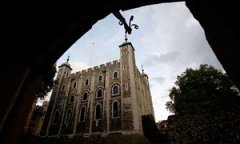Medieval architecture in England
 The White Tower seen at the Tower of London. Photograph: Bloomberg/Bloomberg via Getty Images
The White Tower seen at the Tower of London. Photograph: Bloomberg/Bloomberg via Getty Images
Round churches were something of a fad following the first crusade in the late 11th century. They were modelled on the original Church of the Holy Sepulchre in Jerusalem, built by Constantine over Jesus's tomb in the fourth century. The Normans translated it into their own style in Cambridge, with thick pillars and supporting round arches, and rainbow-like concentric bands of dog-tooth carving.
02
2. Boothby Pagnell Manor, Lincolnshire
More a country pied à terre by modern standards, this is one of the few surviving fragments of domestic architecture from the end of the Norman era c1200. The first floor is only accessible by an external staircase, and contains a hall and a small bedchamber, while the ground-floor undercroft would have been storage and servants' space. It was probably joined to a larger timber structure, all surrounded by a moat. It even has a chimney, which at the time must have been the height of luxury.
Viewing by appointment only, 74
3. St Mary and David, Kilpeck, Herefordshire
The structure is fairly typical of a 12th-century village church, but the carvings here are something else, in both quality and quantity. Around the south door and on the remaining corbels (stone blocks set into the tops of the walls) is a lexicon of British symbolism, with some decidedly pagan entries. There are snakes eating their tails, mythical beasts, even an explicit sheela-na-gig. They almost look like the work of a modern-day cartoonist. There are also Christian figures such as angels and a tree of life over the doorway, but you're left wondering how they got away with it.
Viewing by appointment only, 15
In plain Saxon terms, this 10th-century church tower (c970) is riotous with ornament, dressed up as it is with decorative strips of stone (pilasters), none of which are strictly necessary to the structure. They may be an imitation of timber-frame buildings of the era. The five-light windows around the belfry also verge on the ostentatious but the "long and short" pattern of the tower's cornerstones is more characteristically Saxon. The rest of the church has elements from every subsequent century – from a medieval rood screen to Victorian pews.
William the Conqueror's primary power base, an architectural two-fingered gesture to his reluctant London subjects: he was in charge and he was here to stay. The style was unlike anything else London had seen in scale and workmanship at the time of its construction in 1078. William imported the Caen stone with which to finish the windows and corners (the whitewash came 200 years later). It was impregnable as a military stronghold, but a gloomy royal residence. The Chapel of St John, in the southeast corner of the tower, is an oasis of austere Norman simplicity.






